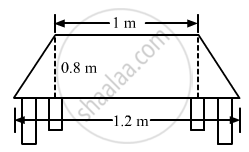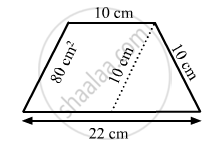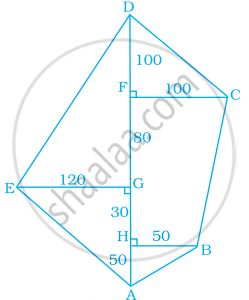Advertisements
Advertisements
Question
Find the missing values.
| Height 'h' | Parallel side 'a` | Parallel side 'b` | Area |
| 19 m | 16 m | 323 sq.m |
Solution
Given: height ‘h’ = 19 m
Parallel sides b = 16 m
Area of the trapezium = 323 sq.m
`1/2` h(a + b) = 323
`1/2` × h × (a + 16) = 323
a + 16 = `(323 xx 2)/19` = 34
a = 34 – 16 = 18 m
a = 18 m
Tabulating the results we get
| Height 'h' | Parallel side 'a` | Parallel side 'b` | Area |
| 19 m | 18 m | 16 m | 323 sq.m |
APPEARS IN
RELATED QUESTIONS
Find the height of a trapezium, the sum of the lengths of whose bases (parallel sides) is 60 cm and whose area is 600 cm2.
Top surface of a table is trapezium in shape. Find its area if its parallel sides are 1 m and 1.2 m and perpendicular distance between them is 0.8 m.
Find the area of a trapezium whose parallel sides are 25 cm, 13 cm and the other sides are 15 cm each.
If the area of a trapezium is 28 cm2 and one of its parallel sides is 6 cm, find the other parallel side if its altitude is 4 cm.
In Fig. 20.38, a parallelogram is drawn in a trapezium, the area of the parallelogram is 80 cm2, find the area of the trapezium.
Find the missing values.
| Height 'h' | Parallel side 'a` | Parallel side 'b` | Area |
| 10 m | 12 m | 20 m |
The area of the trapezium, if the parallel sides are measuring 8 cm and 10 cm and the height 5 cm is
When the non-parallel sides of a trapezium are equal then it is known as
The area of a trapezium with equal non-parallel sides is 168 m2. If the lengths of the parallel sides are 36 m and 20 m, find the length of the non-parallel sides.
Find the area of the following fields. All dimensions are in metres.

